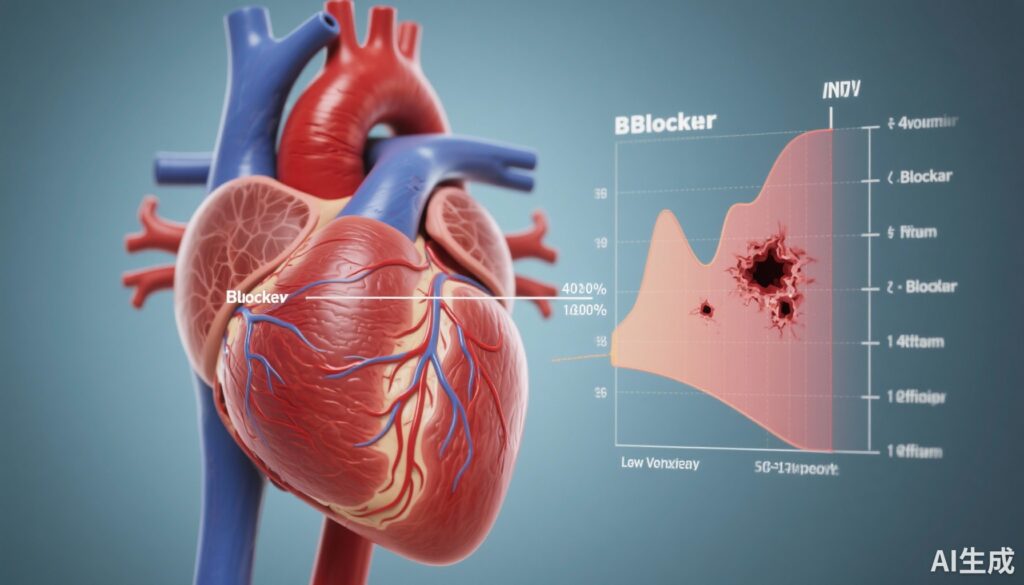Highlight
- β-blocker therapy significantly reduces the composite outcome of all-cause death, recurrent myocardial infarction, and heart failure in patients with recent myocardial infarction and mildly reduced LVEF (40-49%).
- Individual patient data from four randomized controlled trials with nearly 1900 patients confirm the consistent efficacy of β-blockers in this subgroup without heart failure history.
- No significant heterogeneity was noted across trials or countries, supporting the generalizability of findings.
- Findings extend established β-blocker benefits in patients with reduced LVEF to those with mildly reduced ventricular function, addressing a previously uncertain treatment gap.
Background and Disease Burden
Myocardial infarction (MI) remains a leading cause of morbidity and mortality worldwide despite advances in reperfusion strategies and secondary prevention. Left ventricular ejection fraction (LVEF) after MI is a key prognostic indicator influencing therapeutic decisions. While long-term β-blocker therapy is a guideline-recommended cornerstone for MI patients with reduced LVEF (<40%), the benefit for those with mildly reduced LVEF (40-49%) has historically been unclear. This patient population represents a substantial proportion of post-MI survivors and is clinically challenging, as they do not meet criteria for heart failure with reduced ejection fraction (HFrEF) but may still carry elevated risk for adverse cardiovascular outcomes. Hence, identifying optimal management strategies, including the role of β-blockers, has significant implications for secondary prevention and improving long-term survival.
Study Design
This investigation is an individual patient data meta-analysis incorporating four recently completed randomized controlled trials: REBOOT, BETAMI, DANBLOCK, and CAPITAL-RCT. Collectively, these trials examined oral β-blocker therapy initiated within 14 days of an acute MI in patients with LVEF≥40%. This meta-analysis uniquely focuses on the subset of 1885 patients with mildly reduced LVEF (40-49%) and no prior heart failure or clinical signs of heart failure at enrolment.
The primary composite outcome was the incidence of all-cause death, new myocardial infarction, or development of heart failure, assessed over a median follow-up exceeding one year. A one-stage fixed-effects Cox proportional hazards model was utilized to estimate the pooled treatment effect, with centrally adjudicated endpoints ensuring data integrity. The study was prospective-registered in PROSPERO (CRD420251023480), ensuring transparency in methods.
Key Findings
Among the 1885 patients analyzed, 991 received β-blocker therapy, whereas 894 were assigned to no β-blocker (control). Over the follow-up period, the primary composite endpoint occurred in 106 patients in the β-blocker group (32.6 events per 1000 patient-years) versus 129 patients in the control group (43.0 events per 1000 patient-years).
Statistical analysis revealed a statistically significant 25% relative risk reduction (hazard ratio 0.75; 95% confidence interval 0.58 to 0.97; p=0.031) associated with β-blocker treatment. Importantly, the effect was consistent across all four trials without any significant trial-by-treatment interaction (p=0.95) or country-related heterogeneity (p=0.98), underscoring the robustness and broad applicability of the findings.
Secondary safety outcomes showed no unexpected adverse events attributable to β-blockers, supporting their favorable risk-benefit profile in this population.
Expert Commentary
These results address a critical clinical uncertainty by demonstrating that the benefits of β-blockers extend beyond patients with severely reduced LVEF after MI to those with mildly reduced systolic function. Mechanistically, β-blockers decrease myocardial oxygen demand, limit adverse remodeling, and possess anti-arrhythmic properties that are likely beneficial even in mildly impaired ventricles.
Previous trials had insufficient power to draw definite conclusions for this subgroup, hence clinical guidelines often provide ambiguous recommendations. This meta-analysis leveraging individual patient data enhances statistical power and precision of effect estimates.
Nevertheless, limitations include the fixed-effects modeling approach which assumes a consistent treatment effect across studies, and shorter median follow-up durations compared to some heart failure trials. Future investigations assessing long-term adherence, dose optimization, and effect modification by comorbidities are warranted.
Conclusion
For patients with acute myocardial infarction and mildly reduced left ventricular ejection fraction without overt heart failure, β-blocker therapy confers a significant reduction in all-cause mortality, recurrent MI, and heart failure development. This evidence supports the incorporation of β-blockade as a standard secondary prevention measure in this intermediate-risk subgroup, potentially guiding updates in clinical practice guidelines.
Clinicians should consider early initiation and maintenance of β-blocker therapy in appropriate post-MI patients with mildly reduced ejection fraction to optimize cardiovascular outcomes.
Funding and Registration
This meta-analysis was funded by Centro Nacional de Investigaciones Cardiovasculares Carlos III (CNIC), Danish Heart Foundation, Novo Nordisk Foundation, South-Eastern Norway Regional Health Authority, and the Research Council of Norway. The protocol is registered with PROSPERO under CRD420251023480.
References
Rossello X, Prescott EIB, Kristensen AMD, et al. β blockers after myocardial infarction with mildly reduced ejection fraction: an individual patient data meta-analysis of randomised controlled trials. Lancet. 2025 Sep 13;406(10508):1128-1137. doi: 10.1016/S0140-6736(25)01592-2



